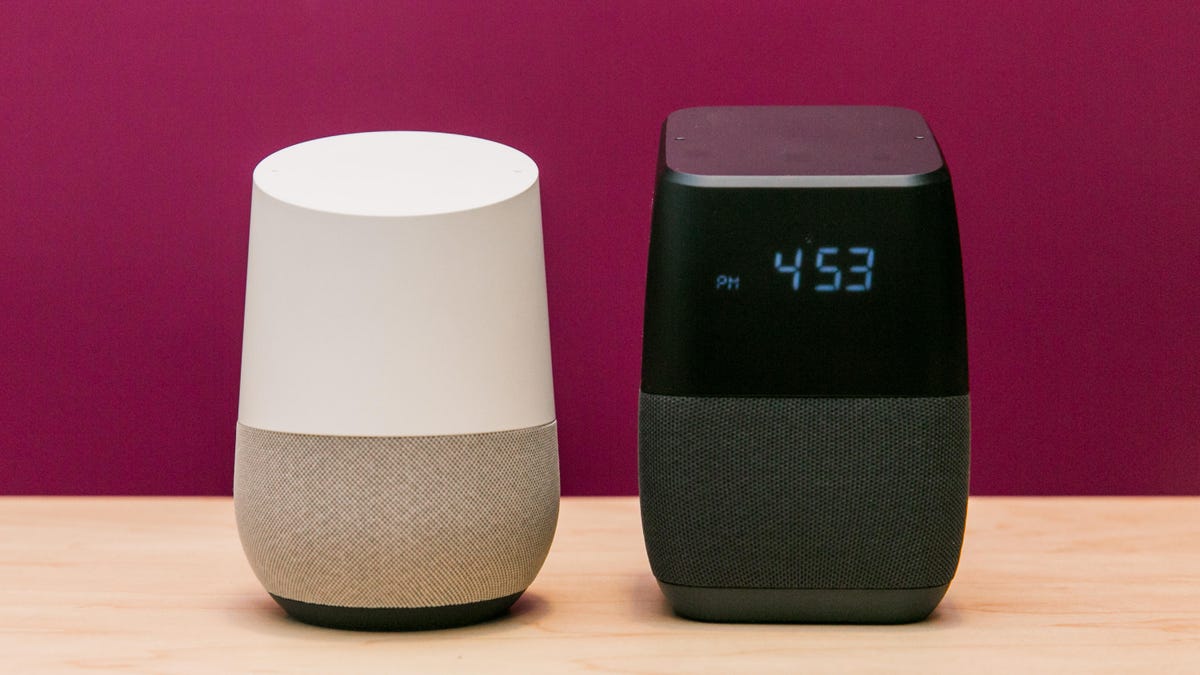 Why You Can Trust CNET
Why You Can Trust CNET Insignia Voice review: Cheap Google Assistant speaker sounds better than Google Home Mini
Could this be the 21st-century clock radio you were looking for?
Though its proper name won't be familiar -- the Insignia NS-CSPGASP -- you may have seen this speaker featured on CNET's daily deals blog, the Cheapskate. The Insignia Voice is a voice-activated Google Assistant speaker that's also an alarm clock, and it regularly goes on sale for as low as $25 (retail price of $100). For half the price of the almost-$50 Google Home Mini , the Insignia can't be any good, can it? I aimed to find out.
The Good
The Bad
The Bottom Line
The Voice is almost exactly the same size as the almost-$130 Google Home speaker -- about as big as some types of air freshener -- and roughly the same shape, albeit more squared-off. The two also appear to have a similar mic array design (one mic on each side of the control panel) with a microphone mute button on the back. Both speakers also have woofers in the bottom of the unit that are hidden by a wrap-around grille.

The $130 Google Home (left) next to the Insignia Voice
Insignia one-ups Google with a display on the front for a clock and alerts. Overall, the Insignia's build quality is surprisingly good for a "cheap speaker" and it has a nice heft.
The top of the unit features the four "listening" dots you'd see on Google's speakers, and if you wave your hand over the Insignia a volume up/down and mute icon appear. Additionally, you can hold the mute button to activate Google Assistant instead of saying, "Hey, Google." There's Bluetooth connectivity in addition to Wi-Fi, and in a nod to nightstand use there's a 5V/1A USB port for charging your phone or other device.
Over the two years since the Home was released Google has refined its setup routine to become pretty foolproof, and the Insignia Voice uses the same setup. The speaker told me to download the Google Home app as soon as I plugged it in, and upon opening the app it informed me it had found the NS-CSPGASP and asked if I wanted to set it up. Sure! After accepting my Wi-Fi password and installing the latest update, the Voice was ready.
The speaker does most things that any Google Assistant device can, including set timers, answer questions and play music. One of the things it won't do, however, is let you use Google Voice for free calls (Insignia says it's working to add this feature). Its clock radio features are completely tied to having an Internet connection and active Google Assistant. For example, you can't set the time or alarms independently -- only by using your voice -- plus there's only one alarm sound.
The microphones on board did a decent job of hearing my voice from 10 feet away when playing music at a moderate volume. At volumes under 70 percent with rowdy rock music, the microphone picked me up each time. At louder volumes I needed to be a lot closer, and the Google Home performed better. On the other hand, the Insignia plays much louder than the Google Home.
The speaker has a 5V USB charging port at the rear.
While I wouldn't pick either the Google Home or the Insignia Voice as my main music speaker, both nevertheless performed better than the Google Home Mini. The Mini sounds fine when used to play back voices but music sounds thin and trebly. The Insignia offers both a bigger sound and heftier bass for about the same price as the Mini.
When compared with the larger Google Home, the Voice wasn't able to offer the same articulation with vocals. The Insignia did sound wider and less directional, however, while the Google Home made it very obvious that the music was coming out of a thin speaker strip at the bottom.
With loud music it was easy to overload the Insignia speaker. For example, songs with deep bass effects like Alt-J's 3WW made the Insignia distort in ripples. The Google Home managed the bass in a much tidier way without distortion.
How much should you spend on this speaker?
At $25 or even $50, the insignia offers a better-sounding alternative to a Google Home Mini with the added bonus of a clock and mobile device charging. If you're asked to pay the full $100, however I'd suggest stretching your budget that little bit more and get a Google Home instead. Overall I was surprised by how not-terrible the Insignia was, so if you're looking for a stocking stuffer or cheap kitchen radio for $25 or so, the Insignia Voice is a very good option.


